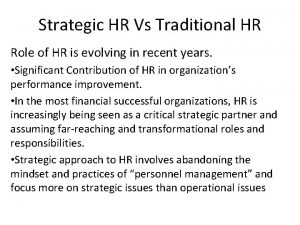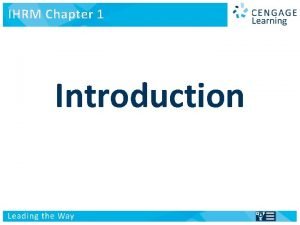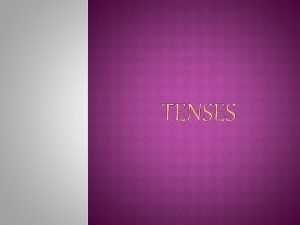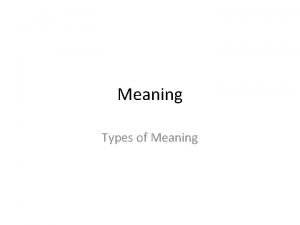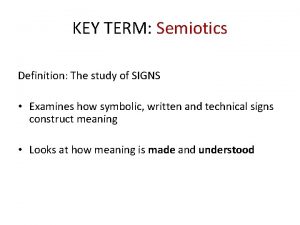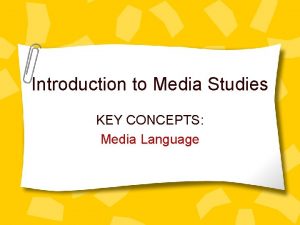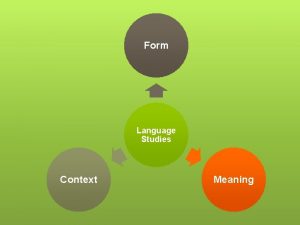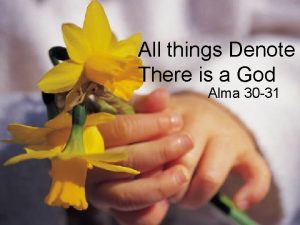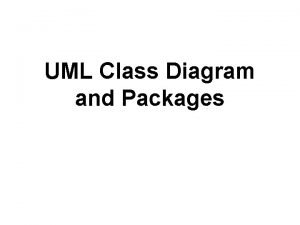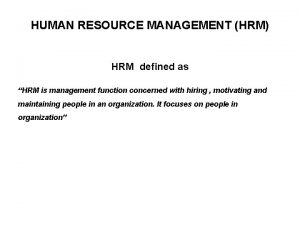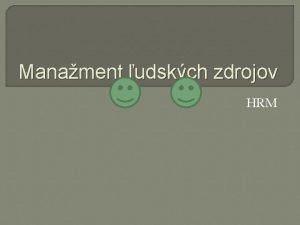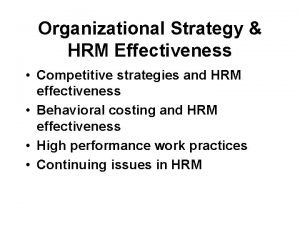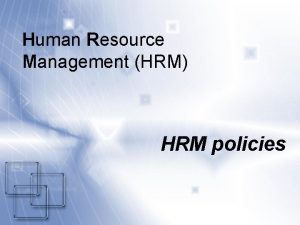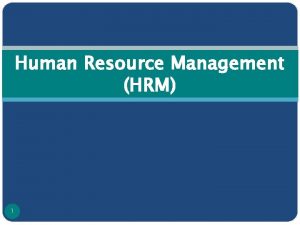HRM A Primer Definition Different terms denote HRM













- Slides: 13

HRM : A Primer

Definition • Different terms denote HRM – labor management, labor administration, labor -management relations, employee-employer relations, industrial relations, personnel administration, personnel management, human capital management, human asset management, and now human resources management

• In simple sense, human resources management means employing people, developing their resources, utilizing, maintaining and compensating their services in tune with the job and organizational requirements.

• Based on Michael P. Jucius and Edwin B Flippo’s works, we define It as – a system of planning, organising, directing and controlling of acquisition, development, compensation, integration, maintenance and separation of human resources for their efficient and effective utilisation to realise the employee goals, business goals and the societal goals.

Goals • Goals of the society include equal employment opportunity, protecting the disadvantaged sections and physically handicapped, encouraging diverse groups, minimization of inequalities in the distribution of income by minimizing wage differentials, or equal wages for equal work, develop the society in general by organizing developmental activities etc.

Goals • Organization goals may include survival, growth and development in addition to profitability, productivity, innovation, excellence etc. • Individual employee- goals consists of job satisfaction, job security , high salary, attractive fringe benefits, challenging work, pride, status, recognition, opportunity for development etc.

Can you pick up the meaning of the following • • • HRM Objectives HRM Policy HRM Procedures HRM Strategy HRM Function

Evolution –World Perspective a. HRM can be traced to England (guilds) 1601. b. The industrial revolution • Scientific management (1) science, not rules of thumb; (2) harmony, not discord; (3) cooperation, not individualism; and (4) maximum output, not restricted output. • Industrial psychology

c. Early personnel specialists (Taylor, Munsterberg, Mayo, Roethlisberger) • welfare secretaries • human relations movement d. Today, HRM works on many activities

EVOLUTION OF HRM IN INDIA Period Status Emphasis 1920 -1939 Clerical Statutory, welfare, paternalism 1940 -1969 Administrative Introduction of rules, procedures etc. 1970 -1989 Managerial Regulatory conformance, imposition of standards 1990 - cont inuing Executive Human values, productivity through people, Employee commitment Chandrasekhar (2000) HRM in Hospitals, in Srinivasan’s Managing Modern Hospital, Sage Pub.

Objectives of HRM • achieve and maintain good human relations within the company • enable each employee to make his/her maximum personal contribution to the effective working of the company • ensure respect and the well being of the individual employee irrespective of their backgrounds • ensure the maximum development for the individual to help the employee contribute his/her best to the company • ensure satisfaction of various needs of individuals for obtaining their maximum contribution to achieve the company goals. Chandrasekhar (2000) HRM in Hospitals, in Srinivasan’s Managing Modern Hospital, Sage Pub.

Personnel Management versus HRM Personnel management Ø Employee alienation is ignored Ø Ø Fear psychosis is created Indifferent to employee problems Policing the poor performers, absentees, late comers, and such like. Ø Ø Confrontation is practiced Ø Ø Ø Power is concentrated Problem’s of Individual solved Inequality in accepting ideas Anonymity of person Knowledge conservation is the motive Distancing from management Manage the people Unions are resented Ø Ø Ø Human resource management Ø Employee commitment, involvement, identification and loyalty are encouraged Ø Trust and confidence promoted Ø Supportive to employees Ø Understanding, providing autonomy and empowerment Ø Collaboration and counselling are arranged Ø Responsibility is shared Ø Problems of group solved Ø Equality of ideas Ø Recognition of person Ø Knowledge dissemination is the motive Ø Proximity with management Ø Manage the performance and process Ø Unions are party to HRD programmes Chandrasekhar (2000) HRM in Hospitals, in Srinivasan’s Managing Modern Hospital, Sage Pub.

General Management Vs. HRM Functions
 Lepak and snell's employment model
Lepak and snell's employment model Difference between domestic and international hrm
Difference between domestic and international hrm Denote action
Denote action Technical definition examples
Technical definition examples Sign signifier signified
Sign signifier signified Connote vs denote
Connote vs denote Language meaning
Language meaning Alma 30 44
Alma 30 44 Optional association multiplicity indicator
Optional association multiplicity indicator Polynomial degrees and terms
Polynomial degrees and terms Combining like terms definition
Combining like terms definition Why do different polymers have different properties
Why do different polymers have different properties Why do different atoms produce different colors
Why do different atoms produce different colors Sound will travel at different speeds in different mediums.
Sound will travel at different speeds in different mediums.
